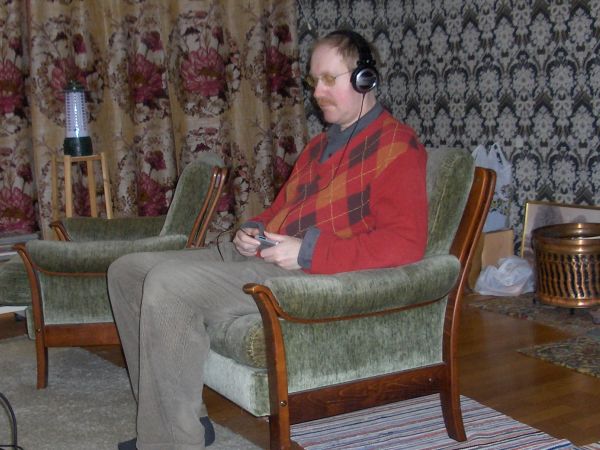
Open your mind and let the New Age of Technology in! Messing around with your brain waves may sound scary, but that’s what they thought about flying too. And before that, running faster than horses. If God wanted us to go beyond our limitations, He would have given us the ability to create!
An online friend complained about insomnia again, so I hurried to recommend delta brainwave entrainment. This little masterpiece of modern science can replace up to 2 hours of sleep with half an hour of entrainment. Beyond that, you run into rapidly diminishing returns – it is not possible to replace sleep entirely, not even if you use several different frequencies of brainwave entrainment. Still, it is pretty impressive.
Unfortunately, it turns out my friend had experimented with brainwave entrainment in the past, on my recommendation, but experienced side effects that were worse than her lack of sleep. Even 10 minutes of delta entrainment caused blurred vision, sometimes migraine, and once she even experienced a seizure afterwards (although it is unclear whether this actually came from the entrainment). Unsurprisingly, she then gave up on the project, despite observing the almost magical effects of the technology.
It is more the rule than the exception that you will experience something when you first start using brainwave entrainment, especially if you start with delta, which is the slowest brainwave frequencies and only dominates naturally during our deepest sleep. So yeah, expect the unexpected. But for most people, the side effects are pleasant or just plain weird. Pain or neurological distortions like blurred vision or temporary loss of short-term memory are rare and typically symptoms of excessive use. The only permanent damage I have heard of is one user who got tinnitus, ringing in the ears. Given the thousands of users of brainwave entrainment, it is as likely as not that the fellow would have developed the problem during the same time period regardless. But who knows. Still, the odds are pretty good that you will benefit, and it is very unlikely that you will malefit, as it were.
Still, I recommend the LifeFlow approach of starting with a more accessible frequency. The LifeFlow program starts at 10 Hz, which is similar to a beginner’s meditation, or the relaxed feeling of lounging in a Stressless chair. It is recommended to use this for 40 minutes a day for two months before moving on to 9 Hz, a slightly deeper form of alpha wave, similar to what you experience the last few minutes before falling asleep. It continues this way down to 1 Hz, which is solid delta and comparable to deep sleep. During a night of sleep, you are unlikely to have delta after the first two sleep cycles unless you are a child. A sleep cycle is 90 minutes, and consists of several phases, so few adults and virtually no elderly get as much as 30 minutes of it naturally. Children do, however, and I don’t think delta entrainment is useful for them. They should get the opportunity to sleep naturally.
As I mentioned, the value of delta entrainment in connection with sleep is that it provides a type of brainwave that we need but which we don’t get much of as we grow older. Sleep consists of four phases, but two of them are particularly important. Deep sleep with delta waves is one of them. The other is REM sleep, or intense lifelike dreaming. Delta occurs naturally only at the beginning of the night, while REM increases gradually with each cycle through the night. Again, children have more of both, elderly less. In fact, elderly often go nights without delta at all, but also have less REM. Their dreams are often so prosaic that they wake up thinking they have not slept at all, despite snoring loudly! When humans – and even animals – are kept awake for a long time, they catch up by having more delta and REM sleep the first night they are allowed to sleep again. This is a pretty good hint that these sleep phases are particularly important.
We don’t know any way to induce REM electronically. Sex will do it in rabbits, or so I have read. But delta waves we can create with precise sound patterns. All you need to do is close your eyes. You don’t even have to think about England. As long as you refrain from intense, primal emotions – fear, anger, lust or disgust – the entrainment will work its magic. You can even worry a little, if you feel the urge, just don’t panic.
But to reduce the risk of creepy side effects, I recommend starting with lighter frequencies (alpha or at least theta) and perhaps even shorter time spans in the beginning. Notice that most side effects are actually either pleasant or just psychedelic, but they are still distracting. The less you think about the experience, the better really. Just close your eyes, relax and let the sound wash over you.
I have an MP3 player with delta tracks beside me on my bed. That way, if I go to bed early enough to not fall asleep instantly, I can spend the time relaxing with delta waves. It is pretty nifty. I am a lot more awake at work than I used to be – I used to need to nap twice or thrice during most workdays, although my naps were brief – and I can now work full days instead of 90%. I still have Delayed Sleep Phase Syndrome and perhaps I will for the rest of my life, but at least now I can do something to reduce the impact on my life.
I should admit that I am not sure it all comes from the brainwave entrainment, I made other changes in my life too. I learned laws of the mind from Happy Science and started to read esoteric books of timeless wisdom by Christian and near-Christian philosophers during the same time frame. It may even be a combination of several of these. Perhaps the passing of a couple years count as well, midlife changes and all that. But from a scientific point of view, when it comes to the effect on daytime sleepiness, brainwave entrainment is the main suspect.
A bit more enthusiastic than me, this fellow LifeFlow user escaped psychiatric hell by the power of brainwave entrainment. There are a number of such stories among the LifeFlow regulars. His review is here at MeditationStars.





 I have reason to believe that the word “headdesk” did not exist until the coming of  computer networks…
I have reason to believe that the word “headdesk” did not exist until the coming of  computer networks…